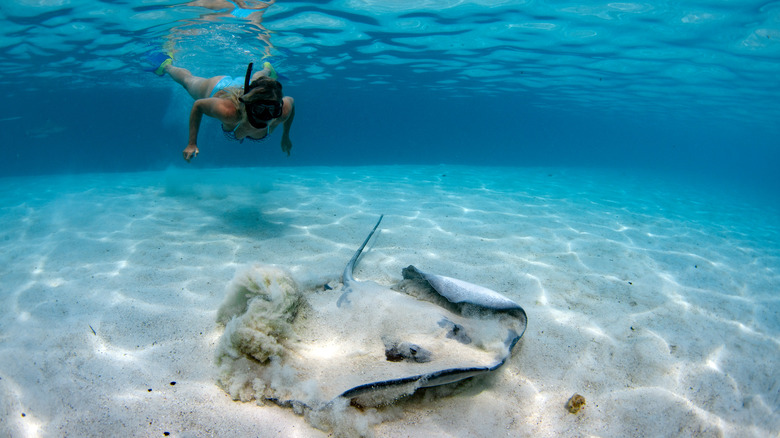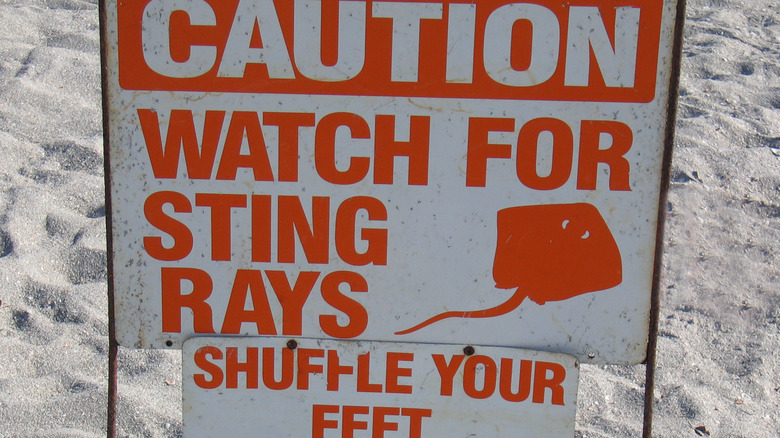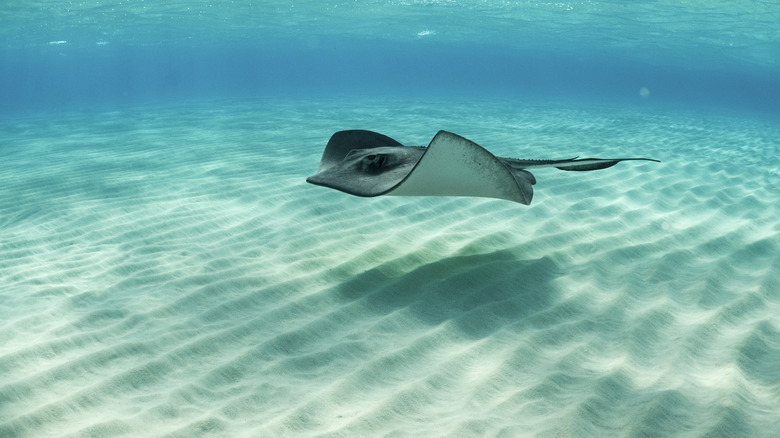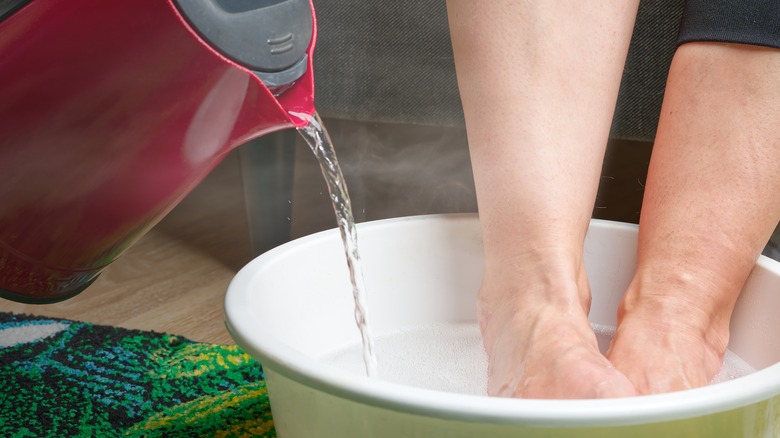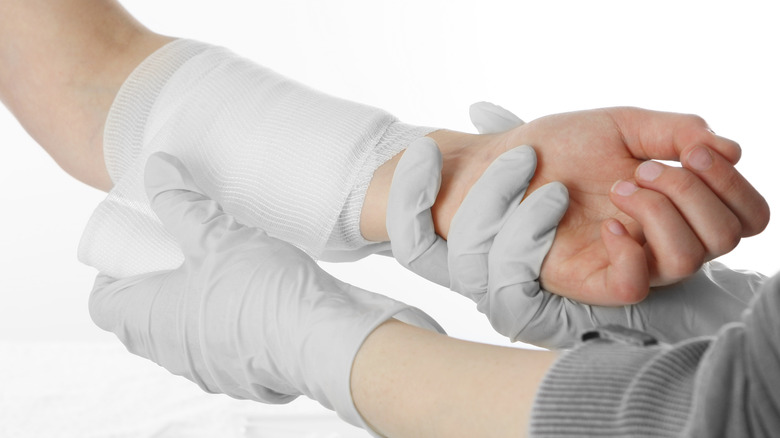What You Should Do If You Get Stung By A Stingray
The stingray gets its name from its venomous barbed tail. It has sharp spines, strong enough to puncture the skin before releasing a painful venom. Every year, around 1,500-2,000 people in the United States are injured by a stingray — but most of these are not life-threatening attacks. While animal lovers will certainly recall the tragic death of "The Crocodile Hunter" Steve Irwin in 2006, after he was stabbed in the chest by a stingray's tail that pierced his heart, stingrays are gentle animals and not usually a deadly threat to humans. They never attack unprovoked, and only sting when they feel threatened by a possible predator.
The best way to avoid stingray stings is to avoid accidentally stepping on them. These shy creatures spend much of their time burrowing in the sand, so it's easy to miss them. Experts advise shuffling through the sand rather than taking normal steps underwater to warn the rays that you are coming, giving them time to swim away. You can also carry a pole and use it to prod the sand before stepping.
But what if it's too late and you've already been stung?
As soon as you get stung
If you or someone near you has been stung by a stingray, you will know immediately, because it's extremely painful. Typically, wounds occur on the feet and lower legs after a person accidentally steps on the ray, but divers swimming close to the sea floor can be stabbed in the chest or stomach — which is far more dangerous.
First, you should assess how dangerous the situation actually is. If the stinger is in your throat, stomach, or chest or has gone fully through one of your limbs, you should leave it where it is, exit the water, and contact emergency medical help immediately.
If the wound is not serious, however, you can pull out the barb before you leave the water and rinse the wound in the sea. Ocean water might not be sterile, but if you've been stung by a stingray chances are the wound has already been exposed to seawater, and it may help remove fragments of the stinger still inside. If you can visually see pieces of the barb, take them out.
Assess the situation onshore
Get to land as soon as possible, contact poison control, and assess if you need to seek emergency medical assistance. If the wound is still actively bleeding, you should work to stop it by applying pressure. If you have a clean bandage, it can help to slow bleeding until help arrives.
Even if the wound seems superficial and the bleeding has stopped, you should keep an eye out for any unusual symptoms that could be signs of an allergic reaction. While stingray stings can be horrible and painful, allergic reactions can be deadly. Serious pain and some swelling around the injury are normal. You may also experience stomach issues like pain, diarrhea, and nausea, symptoms like dizziness and headache, and feelings of anxiety and fatigue. While these symptoms are highly unpleasant, they are not signs of a serious allergic reaction. You should be concerned if you notice difficulty breathing not associated with anxiety, sweating, seizures, paralysis, irregular heartbeat, or fainting. These are not normal and require immediate medical attention.
Drawing out the venom with hot water
Whether or not the wound is dangerous, you will likely be in serious pain from the sting. One of the easiest ways to relieve it is to soak the affected area in hot water. If possible, heat some clean water to a temperature between 110°F and 115°F, or 43°C to 46°C. If you are still on the beach without access to a thermometer, it is fine to estimate a good temperature for the water; just test it out with a part of your body that hasn't been stung to make sure it isn't too hot.
This will very likely reduce the pain, but it doesn't just feel good – it actually helps kill and draw out stingray venom. You may even see the venom, which Healthline describes as looking like jelly, floating in the water. It may take a soak of 30-90 minutes at a consistently warm temperature for it to be less painful.
Cleaning and caring for the injury
After you have finished soaking the sting, it should be significantly less painful. As described in the National Library of Medicine, simply soaking the injury in warm water is enough to relieve the pain for 90% of people with stingray stings, but you may also wish to take an over-the-counter NSAID, like ibuprofen if you have taken them without issue in the past.
If you have access to clean water and soap, after you have lessened the pain somewhat, you should take this opportunity to clean the wound. If you can see any venom or dirt still in the wound, wash them out. If there are still any fragments of barbs inside, you should gently remove them.
Assuming you do not have an allergy to antibiotics, you can put a topical antibiotic cream on the wound if you have one. You should also wrap it in a clean bandage to prevent it from getting dirty again.
At the hospital
If you are experiencing a medical emergency due to a severe wound or an allergic reaction, your condition will be stabilized at the emergency room. If the wound is not as severe but you still need to seek emergency attention, the first thing that your doctor will do is inspect the wound and make sure that you have already gotten all the pieces of the barbs out. If you haven't been able to, they will remove any that they can see. If they are concerned that there are still some in the wound that they haven't been able to remove, they may need to take an X-ray of the area to locate them. If the wound is particularly severe, they may have to remove the shards surgically, but this is rare.
The wound will be cleaned again, and after the wound is clear, they may give you stitches to ensure that it heals up well. You may also receive antibiotics to prevent infection, as well as a tetanus booster.
Healing after the injury
In the vast majority of cases, people thankfully make a full recovery from a stingray sting. Like with any injury, the biggest risks are infection or necrosis, which can, of course, be dangerous. Stingray stings are particularly vulnerable to infections because stingray venom causes some local tissue death, which slows healing, so there is a risk of infection. As long as you are careful about keeping the wound clean and covered, and keep an eye out for signs of infection, it should heal well. If you had to have surgery to remove all the pieces of the barb, your recovery time would be longer.
Assuming that there is no infection, most people feel much better just two days after their sting. After that time, the area where you were stung may still feel numb or tingly. After several weeks, most people have no remaining symptoms whatsoever.

